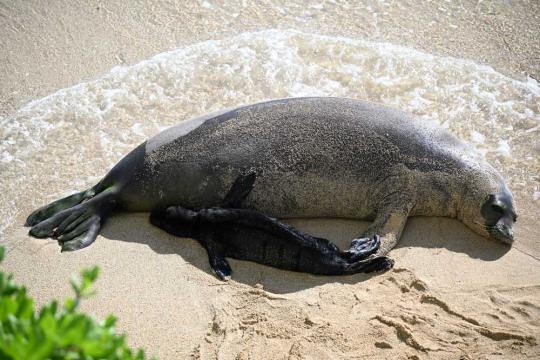 around a Hawaiian monk seal mom laying on a sandy beach as her newborn pup lays next to her resting its head on its mom." width="540" height="360" />
around a Hawaiian monk seal mom laying on a sandy beach as her newborn pup lays next to her resting its head on its mom." width="540" height="360" />Learn how to properly observe and interact with marine life to ensure the well-being of marine species and their habitat.
The public is prohibited from harassing, harming, pursuing, wounding, killing, capturing, or collecting marine species protected by the Endangered Species Act and Marine Mammal Protection Act. NOAA urges members of the public to observe marine animals from a safe and respectful distance, and do not approach or touch them.
Viewing marine animals in their natural habitat can be an exciting experience—watching a group of dolphins leaping across the water, seeing a sea turtle nesting on a beach, or encountering a colony of seals basking in the sun. Although it can be tempting to try to get close to these marine animals, it’s always best to view them from a safe and respectful distance for their safety—and yours. Learning how to interact with and observe ocean animals can help you make the right decisions when you encounter them by water, land, or air.
Regulations and guidelines have been developed with specific recommendations and distances for viewing whales, dolphins, porpoises, seals, sea lions, sea turtles, and other marine animals. These guidelines and laws can vary by state and by species, so know the rules before you visit our coastal waters.
The Marine Mammal Protection Act and the Endangered Species Act do not provide for permits or other authorizations to view or interact with wild marine mammals and sea turtles, except for specific listed purposes such as scientific research. We maintain as policy that interacting with wild marine life outside of permitted research should not be attempted and viewing marine mammals and sea turtles must be conducted in a manner that does not harass the animals. We do not support, condone, approve, or authorize activities that involve closely approaching, interacting, or attempting to interact with whales, dolphins, porpoises, seals, sea lions, and sea turtles in the wild. This includes attempting to swim with, pet, touch, or elicit a reaction from the animals.
 around a Hawaiian monk seal mom laying on a sandy beach as her newborn pup lays next to her resting its head on its mom." width="540" height="360" />
around a Hawaiian monk seal mom laying on a sandy beach as her newborn pup lays next to her resting its head on its mom." width="540" height="360" />
Hawaiian monk seal RK96 (Kaiwi) and her newborn pup at Kaimana Beach, Waikīkī. Credit: NOAA Fisheries (Permit #24359)